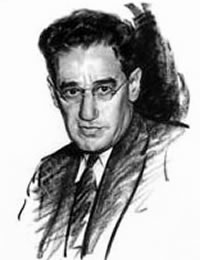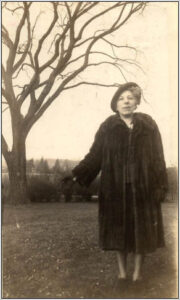The 1920s: Connelly and Ferber
The 1920s: Connelly and Ferber

George S. Kaufman
1889 – 1961
George S. Kaufman’s Biography
The 1920s: Connelly and Ferber
Another drama columnist who made the rounds at the Algonquin was Marc Connelly. Although he and Kaufman were quite different in temperament, the two men enjoyed each other’s wit and company and decided to collaborate on a play. Dulcy (1921), their first effort, was actually inspired by the well-meaning but banal heroine of Franklin P. Adams’ column.
The play, which made a star out of actress Lynn Fontanne, was a great success and set a pattern for the Kaufman/Connelly collaborations, stories of good-natured dolts who manage to outwit their more sophisticated rivals.
There were seven more plays with Connelly in the next three years, the highlights of which were: To The Ladies (1922) with Helen Hayes; Merton of the Movies (1922), Kaufman’s first satire on Hollywood; and Beggar On Horseback (1924), a satire on business, written–uncharacteristically for Kaufman–in the Expressionistic style fashionable at the time.
Kaufman was an avid and expert bridge player; he knew the importance of good partners. Having mutually exhausted their partnership, Kaufman and Connelly went their separate ways and in 1924 Kaufman approached novelist Edna Ferber, whose interest lay in sprawling dynastic dramas of American families, to adapt her novel Old Man Minick for the stage; Minick, as it was finally called, was a hit. He wrote five more plays with Ferber in the following twenty-four years.
These collaborations are among his least frenetically comic plays, but their elegance and wit have made several of them classics of popular culture. The Royal Family (1927) was a veiled encomium to the Barrymore acting clan;
Dinner At Eight (1932) was a painfully poignant and precise portrait of society during the Depression, rendered as a comedy of manners; Stage Door (1936) showed the trials and tribulations of a group of aspiring young actresses. Each of these was, in turn, made into a successful, starrily-cast motion picture, particularly Dinner At Eight (film, 1933).
The latter part of the decade brought a number of unique projects. Kaufman’s only completely solo effort, The Butter and Egg Man, a spoof of theatrical chicanery which presages Mel Brooks’ The Producers, was produced in 1925. In 1929, he wrote June Moon, which was–sadly–his only collaboration with humorist Ring Lardner. The comedy combined Lardner’s acidulous wit with Kaufman’s penchant for wry wisecracks in an unusually bitter look at tunemaking on Tin Pan Alley.
Another drama columnist who made the rounds at the Algonquin was Marc Connelly. Although he and Kaufman were quite different in temperament, the two men enjoyed each other’s wit and company and decided to collaborate on a play. Dulcy (1921), their first effort, was actually inspired by the well-meaning but banal heroine of Franklin P. Adams’ column.
The play, which made a star out of actress Lynn Fontanne, was a great success and set a pattern for the Kaufman/Connelly collaborations, stories of good-natured dolts who manage to outwit their more sophisticated rivals.
There were seven more plays with Connelly in the next three years, the highlights of which were: To The Ladies (1922) with Helen Hayes; Merton of the Movies (1922), Kaufman’s first satire on Hollywood; and Beggar On Horseback (1924), a satire on business, written–uncharacteristically for Kaufman–in the Expressionistic style fashionable at the time.
Kaufman was an avid and expert bridge player; he knew the importance of good partners. Having mutually exhausted their partnership, Kaufman and Connelly went their separate ways and in 1924 Kaufman approached novelist Edna Ferber, whose interest lay in sprawling dynastic dramas of American families, to adapt her novel Old Man Minick for the stage; Minick, as it was finally called, was a hit. He wrote five more plays with Ferber in the following twenty-four years.
These collaborations are among his least frenetically comic plays, but their elegance and wit have made several of them classics of popular culture. The Royal Family (1927) was a veiled encomium to the Barrymore acting clan;
Dinner At Eight (1932) was a painfully poignant and precise portrait of society during the Depression, rendered as a comedy of manners; Stage Door (1936) showed the trials and tribulations of a group of aspiring young actresses. Each of these was, in turn, made into a successful, starrily-cast motion picture, particularly Dinner At Eight (film, 1933).
The latter part of the decade brought a number of unique projects. Kaufman’s only completely solo effort, The Butter and Egg Man, a spoof of theatrical chicanery which presages Mel Brooks’ The Producers, was produced in 1925. In 1929, he wrote June Moon, which was–sadly–his only collaboration with humorist Ring Lardner. The comedy combined Lardner’s acidulous wit with Kaufman’s penchant for wry wisecracks in an unusually bitter look at tunemaking on Tin Pan Alley.
Contact Us Today
Interested in bringing George S. Kaufman’s timeless plays to your stage?
Please refer to the contact information for each specific play on the various collection pages for direct amateur and professional licensing information.
Plays are represented by Concord Theatricals, Broadway Dramatic Licensing, and Music Theatre International respectively
If you are interested in first-class performance or film/television rights:
In the US, George S. Kaufman’s plays are represented by:
CPK Artists, LLC
In the UK, George S. Kaufman’s plays are represented by:
Alan Brodie Representation
For more information about George S. Kaufman or this website, contact:
Laurence Maslon
Literary Trustee, George S. Kaufman Estate










